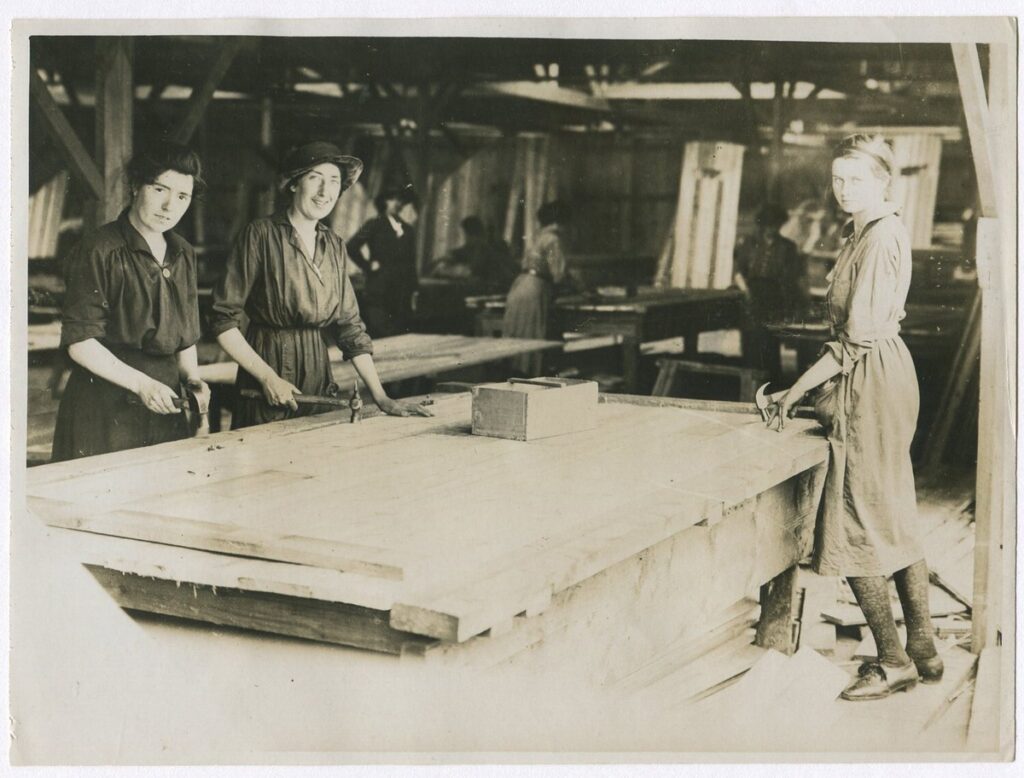The joiners of World War I helped build the war effort from the ground up – and they did it under fire.
Behind every line of defence and every act of survival, there were timber structures holding it all together.
These were the work of joiners and carpenters. Some served in the Royal Engineers, while others joined labour battalions or worked as civilian contractors. Whatever their role, they worked fast and under pressure (often right on the front lines).
They built what couldn’t wait.
So what exactly did they build? Why timber? And why did so few of their names make it into the history books?
What did joiners build during WWI?
They built trenches that kept lines alive. Duckboards over mud that swallowed men whole. Dugouts for command, refuge, and first aid. Railway platforms and emergency repairs to move troops, food and ammunition. Crates that carried everything an army needed.
The British Army Field Engineering Manual (1915) detailed the use of timber in trench construction, including frames for fire steps, trench boards, and shelters. Without these, troops were exposed to the elements and unable to hold their positions.
Without joiners:
- Armies sank
- Supplies stalled
- Wounded soldiers had nowhere to be saved
Working conditions were harsh: construction happened in the cold, in thick mud, often under threat from enemy fire. Many were active-duty soldiers or reservists expected to switch from tools to rifles in an instant. Joinery wasn’t just a support trade, it was often frontline work under extreme pressure.

Why was timber so vital during the First World War?
Concrete and steel had their place, but timber was quick, versatile and could be built with simple tools. It was the most practical material available for frontline construction.
Timber was:
- Lightweight and easy to transport
- Available in large quantities through the British Timber Supply Department (created in 1915)
- Quick to build with, especially under pressure
- Adaptable for a wide range of structures: from field hospitals to observation posts
In 1917, Britain was importing nearly 1 million tonnes of timber each year for military use. Timber huts and stores were used not just at the front but in camps, hospitals and administrative bases across Britain and France.
What else did wartime joiners create?
Beyond trench supports and huts, joiners also constructed:
- Ammunition boxes and crates (over 100 million made during the war)
- Stretchers, splint boxes and surgical frames for medical use
- Observation towers and sniper posts
- Watch huts, bridges, latrines and drying racks
Their work supported everything from logistics to frontline command.
Who were the women carpenters of W.G. Tarrant?
While most joiners were men, some of the most remarkable stories came from women.
When W.G. Tarrant Ltd (a Surrey-based building firm) lost its male workforce to conscription, it obtained government permission to train and employ women as carpenters. Around 150 women were recruited, many of them former munitions workers.


In 1917, they were sent to France to build timber huts near Calais. These huts became:
- Medical stations
- Sleeping quarters
- Kitchens and mess halls
- Stores and HQs for British forces
According to Tarrant, the women built 37,000 huts in total, using over 50,000 lbs of nails each week. Their camp was frequently targeted in air raids. Luckily, there were no casualties.
How Were WW1’s Women Carpenters Recognised?
Despite the scale of their work, they were paid roughly half the rate of their male counterparts. In 1917, Mr Forster stated in the House of Commons:
“Their output and their pay is about half that of men. They do the lighter kinds of carpentry. The Munitions Act does not apply to them.”
But the work was far from light. Photographs from the Imperial War Museum show them lifting large timber sashes alone, wielding saws and assembling entire hut frames. These were essential builds that required strength, skill, and speed under pressure.
They returned to Byfleet in early 1919, welcomed with local celebration but little national recognition. Despite building 37,000 huts and enduring regular air raids, they received no medals. Their story was grouped under the name of a man (Walter George Tarrant). Today, they are often remembered simply as ‘Mr Tarrant’s Lady Carpenters’. It’s a collective title that obscures the individual women and their extraordinary contributions.
Even after long hours of physical labour, they formed a theatre troupe, The Woodsnippers, to perform concerts for wounded soldiers at the front. It was resourceful, human, and a powerful reminder that their contribution went far beyond carpentry alone.
Were joiners and carpenters ever formally recognised?
There is little official record of honours or medals awarded to civilian joiners during WWI. Despite the critical role they played in logistics, mobility, shelter and survival, their contribution remains largely undocumented.
Military joiners within the Royal Engineers may have received standard service recognition, but no campaign medals were created for civilian workers like the women of Tarrant.
They were grouped under company names, referred to collectively, and rarely credited as individuals. Their efforts were filed under logistics. Not valour.

Why should we remember them?
Because battles make history, but builders made the battles possible.
Joiners worked with saws, hammers, and grit. They also worked with rifles slung over their shoulders and seconds to act when shellfire started falling.
Today, when we remember the fighters, we should also remember the builders.
At Gowercroft, we still believe in the value of craftsmanship under pressure. Of working with purpose and precision. And of making timber work harder, longer, and better than anyone expects.